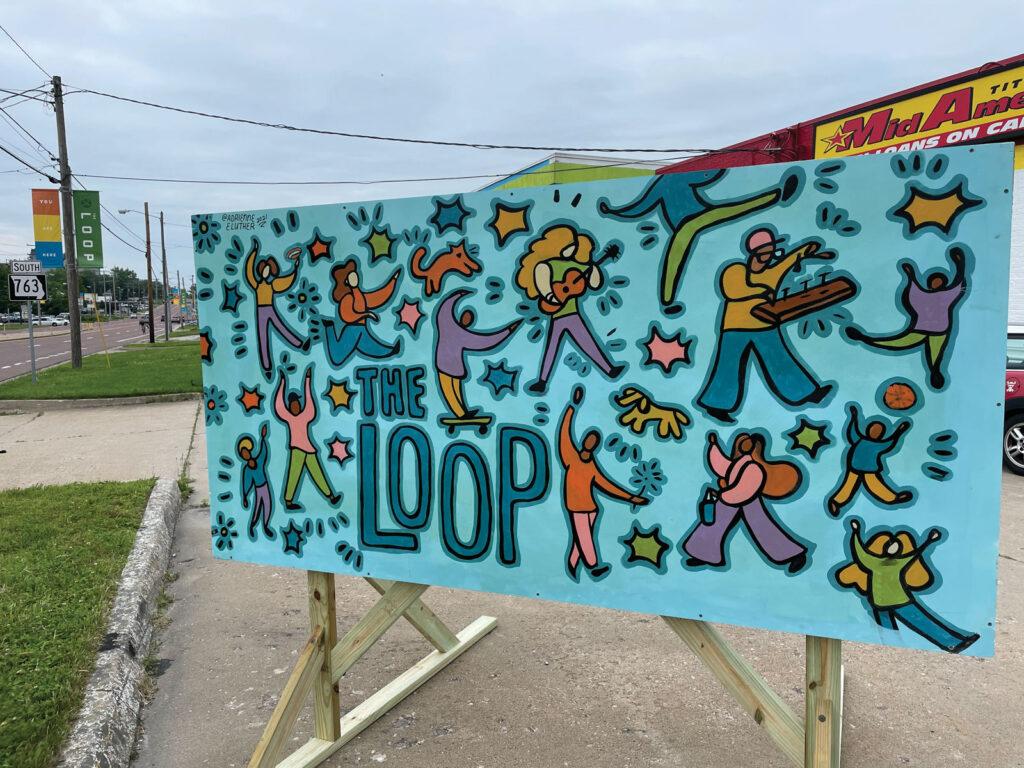Ten years later, The Loop CID counts its gains and attractions.
It’s hard not to notice that change is afoot along the Business Loop 70 corridor.
Commissioned artwork offsets the brick-and-mortar cityscape while colorful banners proclaiming the thoroughfare as a destination for doers and makers affirm that “You Are Here.” Such signs are just the tip of the iceberg, for what started years ago as a grassroots effort by business and property owners along this roadway has metamorphosized into its own independent government agency known as The Business Loop Community Improvement District (CID) — and it means business.
Carrie Gartner, executive director of The Loop, explains a bit about the motivation and arduous process of forming the organization in the first place.
“It started with a group looking to improve the infrastructure of the street. They were interested in making it walkable, making it more attractive. Three of the entrances into Columbia off [Interstate] 70 are onto the Business Loop and they didn’t think we were putting our best foot forward,” Gartner says.



Volunteers set about consensus building and defining a shared vision for The Loop, circulating a petition in the region to establish a district, obtaining approval on a majority of property values for self-assessment, getting consent through the city council to form a CID, and going through a general election process where a half-cent sales tax within the district was implemented through the vote.
Michele Batye, owner and president of Dave Griggs Flooring America and current chair of the CID board, chronicles some important steps, noting, “Through the Smart Growth America grant we branded ourselves a collection of makers.”
That funding, awarded to only six organizations nationally, encourages local, small-scale manufacturing to revitalize an underperforming area of a city and create new economic opportunities. The Loop generated its Maker City Plan to reflect inherently the same do-it-yourself ethos that defines the Business Loop itself. Bayte has been with Dave Griggs for thirty-two of the nearly fifty years the company has conducted its operation on Business Loop 70.
“We are a state roadway which has been minimally maintained, but despite the street’s neglect, we are a corridor of long-established, successful businesses, educational institutions, not-for-profit agencies and city municipalities,” Bayte says of the corridor’s unique structure.
Gartner affirms the spirit of the corridor as she recognizes the challenge that Business Loop 70 not being a city street has posed to its betterment.
“It used to be Highway 40,” she explains “It is owned by the Missouri Department of Transportation, and they have very strict rules for what you can and can’t do on their roads but no money to allocate to the city to handle maintenance deferred since the 1960s.”
Gartner concludes that, ultimately, “We need the city to take over the street if we want it to improve.”
The CID is one step in the lofty goals reflected in The Loop Corridor Plan. The ten-year concept plan entails creating a welcoming, attractive, and economically vital street which can compete in the marketplace for investment and long-term viability.
She is encouraged that the city was recently awarded $2.13 million for a planning study required by the feds. That effort will include environmental, engineering, safety, and storm water management studies. All the planning that must happen before the first shovel digs into the ground.
Gartner hints that the public should “keep an eye out for the huge planning process as it gets started in the next five to six months, because that’s the best chance we have of turning this street into something that we can be proud of as Columbians.”
Along The Loop, work in progress is noticeable and notable successes include the Pop-up Park which was built in an empty lot and now hosts community events including spring and fall makers markets. The markets feature artisans, cooks, makers, and crafters offering handcrafted, one-of-a-kind items.
CoMo Cooks Shared Kitchen is making waves with its commercial kitchen as a food business incubator that is currently servicing more than thirty entrepreneurs. Within CoMo Cooks is The Packing House Production Kitchen where those interested in making value-added products can begin production. That element of CoMo Cooks includes local farmers.
Also at the landmark plaza, Moberly Area Community College’s Columbia campus acts as an engine for workforce development. Its affiliated MACCLab Makerspace is a growing community resource.
“Our goal is to be a workspace open to all makers, creators, doers, and entrepreneurs in mid-Missouri,” says MACCLab Director Maggie Holper.
In 2020, Columbia was named an Etsy Maker City and received a grant for inclusive growth. To further calcify The Loop as the city’s Makers Row and support its community of artisans and makers, the CID created a shared branding program called the Cre[8] brand. Visit www.cre8como.com for details and a listing of makers.
Additional shared spaces near the CID and within the Cre[8] brand include Columbia Gadget Works for those interested in computers, electronics, and digital devices, and VidWest Studios, a community media center offering photography, audio, and video tools and resources.
“You drive down the Business Loop and there is a lot happening inside that you just can’t see when you’re on the street,” Gartner says, reminding passersby that by patronizing businesses along The Loop, residents are contributing to the groundswell of vitality taking place there.










